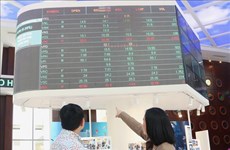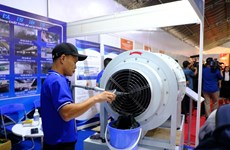Economist urges new model of economic growth
Economists have warned that Vietnam could fall into the
middle-income “trap” with its current economic model of growth, which
has revealed several limitations and weaknesses.
Economists have warned that Vietnam could fall into the
middle-income “trap” with its current economic model of growth, which
has revealed several limitations and weaknesses.
At a recent seminar discussing models for Vietnam’s economic development between 2011-2020, economists said that the country’s 20-year renovation has transformed Vietnam from being a low-income to a middle-income country and that it used the right model of economic development for the 1990s, when the average income was a mere 200 USD a year.
However, its current market economy, which is integrating further into the world, has revealed a number of weaknesses, as for a long time it has largely relied on natural resources, a cheap workforce and indiscriminate investments.
Between 1991-2009, the agricultural, forestry, fishery and mining industries accounted for 30 percent of the nation’s GDP but they have exhausted the country’s natural resources and at the same time damaged the environment.
Also, relying substantially on outsourcing deals has made the national economy largely depend on imported machinery and raw materials while real earnings from exports remain low. Unexpected risks stemming from price fluctuations in the world market have also made the country suffer from a widening trade deficit.
One example is the garments and textiles sector, which earned over 9.1 billion USD in export earnings in 2009, however, 70 percent of this came from outsourcing deals.
As the country maintained an investment rate of over 31 percent of GDP between 1990-2008, inflation soared between 2004 and 2008 and only fell back in 2009 when the Government introduced a range of drastic measures.
These limitations and weaknesses have made Vietnam ’s economy more vulnerable to fluctuations in the global economy and it lacks a firm foundation for maintaining a high and stable growth rate.
“Under the existing economic model based mostly on cheap, unskilled workers and widespread investment, the country has posted an unstable growth rate, which has followed a cycle of dropping to around five percent every 9-10 years,” said Professor Nguyen Dinh Huong from the National Assembly Standing Committee’s Law Research Institute, who quoted the figures at 4.7 percent for 1989, 4.8 percent for 1999 and 5.3 percent in 2009.
Accordingly, Vietnam urgently needs to choose and follow a new and appropriate economic model to be able to integrate further into the world, said Dr. Ha Van Hien, Chairman of the National Assembly’s Economic Committee.
Professor Kenosha Ono from Japan ’s National Policy Research Institute reminded the seminar that Vietnam ’s future economic development model needs to be backed by a skilled workforce and modern technologies.
Vietnam needs to transform itself into a knowledge-based economy, develop skilled human resources and renew the ways it comes up with policies, said the Japanese professor.
Professor Bui Quang Binh from Da Nang University proposed that any new economic development model should focus on rearranging the structure of the workforce, encourage businesses to upgrade their technologies and machinery and increase the efficiency of investments, especially in the public sector./.
At a recent seminar discussing models for Vietnam’s economic development between 2011-2020, economists said that the country’s 20-year renovation has transformed Vietnam from being a low-income to a middle-income country and that it used the right model of economic development for the 1990s, when the average income was a mere 200 USD a year.
However, its current market economy, which is integrating further into the world, has revealed a number of weaknesses, as for a long time it has largely relied on natural resources, a cheap workforce and indiscriminate investments.
Between 1991-2009, the agricultural, forestry, fishery and mining industries accounted for 30 percent of the nation’s GDP but they have exhausted the country’s natural resources and at the same time damaged the environment.
Also, relying substantially on outsourcing deals has made the national economy largely depend on imported machinery and raw materials while real earnings from exports remain low. Unexpected risks stemming from price fluctuations in the world market have also made the country suffer from a widening trade deficit.
One example is the garments and textiles sector, which earned over 9.1 billion USD in export earnings in 2009, however, 70 percent of this came from outsourcing deals.
As the country maintained an investment rate of over 31 percent of GDP between 1990-2008, inflation soared between 2004 and 2008 and only fell back in 2009 when the Government introduced a range of drastic measures.
These limitations and weaknesses have made Vietnam ’s economy more vulnerable to fluctuations in the global economy and it lacks a firm foundation for maintaining a high and stable growth rate.
“Under the existing economic model based mostly on cheap, unskilled workers and widespread investment, the country has posted an unstable growth rate, which has followed a cycle of dropping to around five percent every 9-10 years,” said Professor Nguyen Dinh Huong from the National Assembly Standing Committee’s Law Research Institute, who quoted the figures at 4.7 percent for 1989, 4.8 percent for 1999 and 5.3 percent in 2009.
Accordingly, Vietnam urgently needs to choose and follow a new and appropriate economic model to be able to integrate further into the world, said Dr. Ha Van Hien, Chairman of the National Assembly’s Economic Committee.
Professor Kenosha Ono from Japan ’s National Policy Research Institute reminded the seminar that Vietnam ’s future economic development model needs to be backed by a skilled workforce and modern technologies.
Vietnam needs to transform itself into a knowledge-based economy, develop skilled human resources and renew the ways it comes up with policies, said the Japanese professor.
Professor Bui Quang Binh from Da Nang University proposed that any new economic development model should focus on rearranging the structure of the workforce, encourage businesses to upgrade their technologies and machinery and increase the efficiency of investments, especially in the public sector./.













